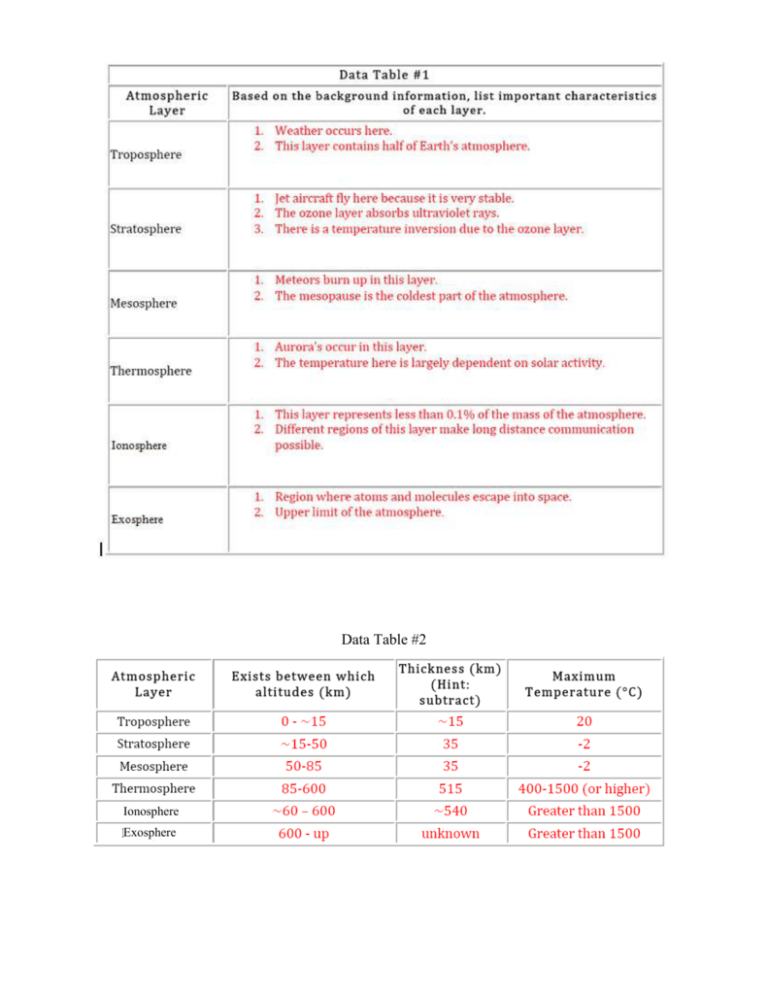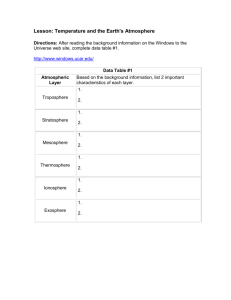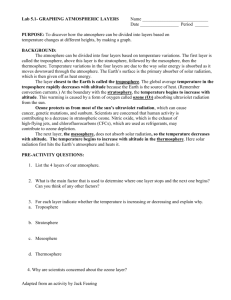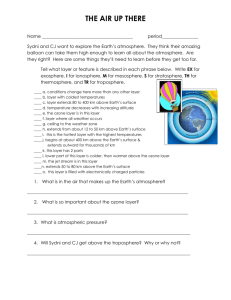Data Table #2 Data Table #3 Atmospheric Layer Describe what
advertisement

Data Table #2 Ionosphere Exosphere Atmospheric Layer Troposphere Stratosphere Mesosphere Thermosphere Ionosphere Exosphere Data Table #3 Describe what happens to the temperature as altitude increases. Be sure to note specific altitudes where abrupt changes occur and how each layer is heated. Temperature decreases as altitude increases. Earth absorbs electromagnetic radiation, re-‐radiates it as infrared radiation (heat), which causes air to rise, expands, and cools. Abrupt change at 10 km. Temperature increases as altitude increases (opposite of the troposphere). The ozone layer is located in the stratosphere; ozone absorbs ultraviolet radiation, heating the surrounding air in the stratosphere. Abrupt change in trend at 50 km. Temperature decreases as altitude increases (similar to what we saw in the troposphere). Abrupt change at 90 km. Temperature increases as altitude increases due to solar radiation (no overlying atmosphere to block any of the incoming radiation). Temperature increases due to solar radiation. The ionization process releases energy which heats up the upper atmosphere. Temperature increases due to solar radiation (same as thermosphere). Technically, the exosphere is considered part of the thermosphere by many sources! Study the graph, "The Average Temperature Profile of the Earth's Atmosphere". Does information there help you to explain why scientists decided where one layer of atmosphere ended and the next one began? Explain your answer. Layers are divided by the behavior of the temperature. The point where temperature switches from warming to cooling (or cooling to warming) is where the boundary of the layers is located. What important layer exists within the stratosphere? The Ozone Layer What is the importance of this layer within the stratosphere? The ozone layer absorbs 97% to 99% of the incoming ultraviolet radiation. Over-exposure to ultraviolet radiation can be dangerous to many living things, including humans. Some of the consequences of overexposure to UV radiation include intense sunburns and skin cancer. Thus, the ozone layer plays a critical role in protecting living things from over-exposure to UV radiation. After reviewing the effects of both “good” and “bad” ozone, how do you think our lives would be different if the “good” ozone were destroyed? Technically speaking, there is no difference between the “good” and “bad” ozone, other than LOCATION. However, if “good” ozone were destroyed (the ozone up high in the stratosphere), most of the incoming ultraviolet radiation would strike Earth, causing a drastic increase in the occurrence of intense sunburns and skin cancer, potentially lowering the lifespan for humans and other organisms that are sensitive to UV radiation. There could even be a disruption in the food chain due to population declines and even extinctions of certain organisms. Humans would also probably have to change our behavior; we would need to avoid going outside or always wear protective clothing outdoors in order to minimize risk of exposure to UV radiation. What important layer exists within the thermosphere? The Ionosphere What is the importance of this layer within the thermosphere? The ionosphere makes long distance radio communication possible by reflecting radio waves back towards Earth. Summarize the differences between the D, E, and F layers. Be sure to pay close attention to which wavelengths of sunlight are absorbed and which wavelengths are reflected. If the ionosphere did not exist, what do you think might be some possible consequences to humans? Think about which wavelengths the ionosphere blocks and what would happen if these wavelengths were allowed through the atmosphere to the Earth’s surface. Without the ionosphere, X‐rays would strike Earth, causing a significant increase in cancer. In addition, long distance radio communication would require satellites. While satellites are often used today to broadcast and transmit cell phone, cable, and internet data around the world, the first telecommunications satellites did not exist until the 1960s, which was a good 60 years after the first radio networks began to appear in the early 1900s. How does an increase in solar activity affect the ionosphere? Why do you think this effect on the ionosphere is observed on the dayside and not the night side of the Earth? The Sun's light is responsible for most of the ionization, as evidenced by the fact that the ionosphere reaches maximum densities just after local noon, when the sun’s rays are most intense. Based on this observation, the density of ionized gasses in the ionosphere should increase with increased solar activity. What is photoionization? Photoionization is the formation of an ion when an electron is knocked free from a neutral atmospheric particle by ultraviolet radiation.








